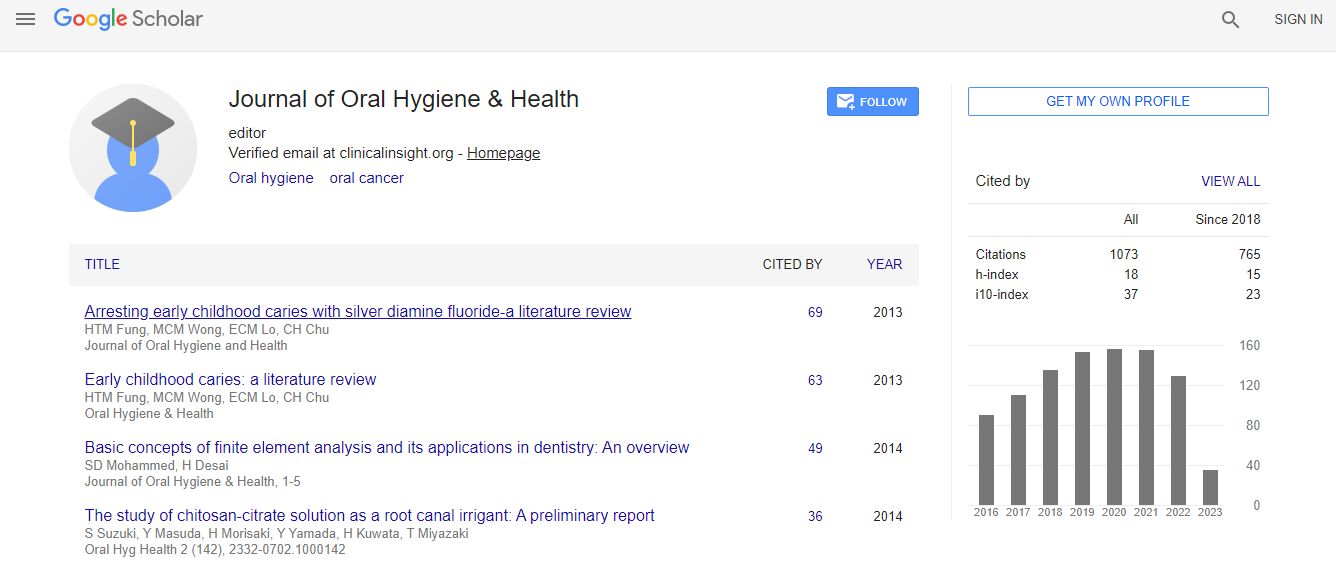Research Article
Is there Association between Self-reported Dental visits, Tooth Brushing, Fluoride use and Perceived Oral Health Status?
de Palma P1*, Ibrahim AA1, Bambaei C1 and Tessma MK21Department of Dental Medicine, Division of Periodontology, Karolinska Institutet, Huddinge, Sweden
2Medical Statistics Unit, Learning, Informatics Management and Ethics (LIME), Karolinska Institutet, Huddinge, Sweden
- *Corresponding Author:
- de Palma P
Department of Dental Medicine, Division of Periodontology
Karolinska Institutet, Huddinge, Sweden
Tel: 46 8 524 881 29
Fax: 46 8 711 8343
E-mail: PatriciaDe.Palma@ki.se
Received date: June 29, 2016; Accepted date: July 24, 2016; Published date: July 29, 2016
Citation: de Palma P, Ibrahim AA, Bambaei C, Tessma MK (2016) Is there Association between Self-reported Dental visits, Tooth Brushing, Fluoride use and Perceived Oral Health Status?. J Oral Hyg Health 4:206. doi: 10.4172/2332- 0702.1000206
Copyright: © 2016 de Palma P, et al. This is an open-access article distributed under the terms of the Creative Commons Attribution License, which permits unrestricted use, distribution, and reproduction in any medium, provided the original author and source are credited.
Abstract
Objectives: Many studies have demonstrated the importance of oral health perceptions in predicting oral health behaviour. Despite the theoretical importance of this concept, the association between self-perceived oral health status and oral health practices has been given relatively little attention in Zimbabwe. The objective of this study was to examine the association between self-reported dental visit, tooth brushing, fluoride use and self-perceived oral health status.
Methods: A cross sectional study was conducted and the information was collected using self-administered anonymous structured questionnaire. The sample included high school students from a boarding school in Zimbabwe. The questionnaire includes items on socio-demographic variables, knowledge of oral health, oral health behaviour and self-perceived oral health status. Self-reported dental visit, tooth brushing and fluoride use were the outcome variables. Perceived health status and selected demographic and oral health variables were taken as explanatory variables. Perceived oral health status was reported as poor, good and excellent.
Result: Multivariable logistic regression revealed that dental visit was associated with selfperceived status of the teeth [OR for excellent teeth=3.8 (95% CI, 1.3, 11.0, p=0.015)] and toothache [OR=2.6 (95% CI, 1.3, 5.2, p=0.005)]. Tooth brushing was positively associated with Age [OR=1.7 (95% CI, 1.1, 2.6, p=0.011)] and self-perceived status of the teeth [OR for excellent teeth=20.6 (95% CI, 2.3, 182.3, p=0.006)]. A significant positive association was observed between fluoride use and self-perceived status of the teeth [OR for excellent teeth = 14.3 (95% CI, 2.3, 89.2, p=0.004)] after controlling for age and fluoride knowledge.
Conclusion: Students with good perceived status of teeth are more likely to have regular dental visit, tooth brushing and use fluorine.

 Spanish
Spanish  Chinese
Chinese  Russian
Russian  German
German  French
French  Japanese
Japanese  Portuguese
Portuguese  Hindi
Hindi 
